|
Welcome to A&A. There are 19 reviews in this issue. Click on an artist to jump to the review, or simply scroll through the list. If you want information on any particular release, check out the Label info page. All reviews are written by Jon Worley unless otherwise noted. If you have any problems, criticisms or suggestions, drop me a line.
|
|
|
A&A #264 reviews (May 2005)
������������������������������������� 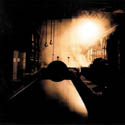 Angels AngelsAngels CD5 (Public Eyesore) Perhaps most intriguing because of its age (this album was recorded in 1981 and 1982), this set of linear power trio musings is something close to sublime. Not for the sound, which is positively abysmal. The studio tracks sound like old school demos, and the live sound isn't much better than mediocre bootleg. Still, the ideas within these songs are exciting enough to overcome the extremely primitive production. Suffice it to say Hiromi Unakami's guitar spans the gap between Frank Zappa and Duane Denison, with a real post-rock kinda feel to it. The vocals are in Japanese (Angels are--or were--a Japanese outfit) and are gawdawful. alternately droning or simply moaning, they don't really do much for the music. But then, the sound is so bad that it's quite easy to simply tune them out as just more background noise. Pay attention to the music. Unakami's guitar is amazing, and the rest of the band is more than capable. One for the fetishists, I guess, but a real treat for me nonetheless.
Contact:
 Autodidact AutodidactDevotional Hymns for the Women of Anu (Public Eyesore) Anyone who would give their songs names like "Cry Me a River, Elizabeth Nietzsche" and "SS Fuck Puppets of the She-Wolf Ilsa" must be dreadfully interesting. Those titles are funny on too many levels to count. Autodidact caterwauls its way into the senses with the scratchy, power feel of early Godflesh while leaning on distorted melody and mechanistic percussion for wider appeal. My understanding is that this band is from Austin. At least, that's where the thing was recorded. But it could be from anywhere. This music not only sounds antisocial, it veers off on so many arcane paths that even I (who love this sorta thing) get lost now and then. Still, the mechanical rhythm structure generally gets things back on track. And no matter how wiggy things tend to get, there's always something interesting going on behind the wall of sonic disturbances. Trying to pierce that shield of white noise isn't easy, but it can be fun. Yep, another one of those head scratchers I love so much. The 50 or so of my readers who dig this sorta thing are probably chomping at the bit by now. The rest of you can move on, your sanity still intact.
Contact:
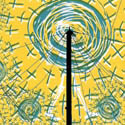 Big
Bear Big
BearBig Bear (Monitor) No wave with a prog twist. A lot like U.S. Maple working its way through King Crimson. Loads stranger and cooler than it sounds, too. Damned if I can really describe this any further. There are two guitars which seem to play rhythm or lead at their leisure, although most of the time they both play lead, sometimes playing in parallel, separated by one meager octave. Thing is, I never could predict what might happen next. That, of course, is a very good thing. Predictable rock and roll sucks. Big Bear is anything but. Maybe it's simply been too long since I've heard something in the same ballpark, but Big Bear simply knocks me out. The power, the pain, the sheer agony of the enterprise enthralls me. Turn to 11. And then try to up it to 12.
Contact:
Channing Cope Sugar in Our Blood (54-40 or Fight!) The music is very similar to the bands I've reviewed above, but the presentation couldn't be more different. Channing Cope adheres to that whole post-prog, post-rock, math rock kinda axis, spinning songs that don't so much progress as evolve, but the sound is soft and inviting. A very jazz way to do this kinda thing. And you know, it's just as satisfying. Channing Cope invests more energy in finding cool melodic lines than selling them to the audience (that would be the math speaking, I guess), but man, what lines! The thoughts expressed in the tangents and curves of these songs would need thousands of words to explain properly. The more I hear of this sound, the more I like it. Kinda like listening to Stanley Jordan cruise through modern rock theory. Hey, when something works, stick with it, right? And boy does this work. Yes, the sound is much more commercially viable than that on the albums above, but that's not the reason these boys use it. They sound like this because this is the sound of Channing Cope. And it's a damned good sound at that.
Contact:
 Lisle Ellis/Peter Valsamis/Marco Eneidi Lisle Ellis/Peter Valsamis/Marco EneidiSound on Survival (Live) (Henceforth) Lisle Ellis on bass, Marco Eneidi on sax and Peter Valsamis on drums. Three guys, four improvisations. That ought to be enough to either entice or drive away most of my readers. Those of you who stuck around will be happy to know that while these pieces are improvised, they do have structure and form. These songs adhere to principles set down by the musicians--consciously or subconsciously, though I'd bet the former. I'm not entirely sure what these principles might be, but I can here more than mere personal familiarity in this music. These songs explode with life and vibrant ideas. As the liners say. "...more often than not...the songs come to an arbitrated (not arbitrary) ending." Exactly. All tangents aside, these men know what they're doing and, more importantly, where they're going. Not that this disc is going to make a believer out of someone who eschews improvisation. Hardly. But this is improvisation of the highest order, the type that inspires on repeat listens just as much (if not more) than the first.
Contact:
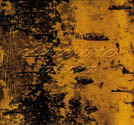 Esmerine
EsmerineAurora (Madrona) More of that searching, yearning, high lonesome stuff that has found a new home in Montreal. By and large the work of Beckie Foon and Bruce Cawdron (with a few friends chipping in now and again), Esmerine builds its songs around cello and unconventional percussion. Okay, so maybe the percussion used isn't so odd, but the way it is played creates some really cool tones. When those are combined with the cello, the effect is damned spooky. A lot like Dirty Three--if you replaced the fiddle with cello and dropped the guitar. The sense of rolling motion is quite similar, as is the pervasive mood of slight unease. The sound on this album is quite stark. My ears tell me that this was recorded live in a miked room. I think the cellos may have been miked separately, but they mix in so well that I'm not entirely sure of that. One of those wordless albums that speaks most eloquently. Aurora is a haunting work, one that challenges and ultimately rewards those who complete the journey. Life is beautiful, but it's not without pitfalls. Esmerine knows all about that.
Contact:
������������������������������ ������������������������������������� 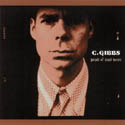 C. Gibbs C. GibbsParade of Small Horses (Dren) He's not ancient, but Christian Gibbs has already lived a long life in music. He's been a hired hand, frontman for the Morning Glories, major label solo artist and now indie hero. After all that, he's either burnt out or he has plenty of stories to last the rest of his life. Judging by the wide scope of this, his fourth solo outing, Gibbs will be telling stories long after he's put into the ground. And he'll be telling them in style. Much like Neil Young--an obvious influence--Gibbs changes his voice and music to fit the song. Yes, all of this fits loosely into that whole alt. country/Americana sound, but there's a lot more in there as well. Each song tells a story. A hint: If you ever want to know if a songwriter will have legs, listen for character definition within his or her lyrics. If the point of view remains static, so will the songs. Gibbs not only inhabits his lyrics with real characters and ideas, he also make sure that the music fits the subject as well. Stylish and supremely assured, Gibbs has made one of those albums that threatens to echo well into the future. There's not a clunker in the set, and most of the songs sparkle with an energy can is rarely found. Few do it better.
Contact:
 Collin Herring Collin HerringThe Other Side of Kindness (self-released) It's tempting to say that Collin Herring sounds like Ryan Adams without ADHD. His voice is a dead ringer for Adams's at times, and that's too bad. Because Herring writes some great songs, and he plays them with a controlled reckless abandon that is almost impossible to achieve. His writing style reminds me of the Alice Despard's more country-ish moments. There's some punchy percussion, some slightly understated vocals and one (or more) melodic counterpoints. And while Herring is willing to get all rough and tumble when necessary, most of this album is burnished to a shimmery indie shine. Indeed, even the cheapest CDs these days sound professional. So the trick comes in knowing when enough is enough--or even when to introduce the occasional "amateur" element into the mix to dirty things up a touch. Herring deftly manages this task, giving each song the sound it needs. Herring ought to get past the Ryan Adams comparisons soon enough. He's more adventurous (at least within the confines of a single album) than Adams, and he's got a vision of his sound that is impressive. The sort of album that will be treasured for years.
Contact:
�������������������������������������  The Koffin Kats
The Koffin KatsInhumane (Psychobilly/Hairball 8) I suppose the label names are self-explanatory. The Koffin Kats play full-tilt distortion-laden rockabilly with a hardcore attitude. A long time ago, Eugene Chadbourne led the band Shockabilly. I guess the term "psychobilly" comes from that. Or maybe not. It does roll of the tongue nicely. In any case, the Koffin Kats play a most spirited version of this sound. The guys have a nice way of simply blasting through whatever trouble spots a give song may have. Play it loud, play it fast and maybe no one will notice. I think that's true, actually. One of the cool things about a sound like this is the energy. The production is raw enough to ensure a feeling of sheer power, and the frenetic performances simply drive that even further. Not the most sophisticated album in the world or anything, but one that accomplishes what it set out to do, nonetheless. Highly enjoyable. Take the ride.
Contact:
 Th' Legendary Shack Shakers Th' Legendary Shack ShakersBelieve (Yep Roc) I think Firewater was the last band to combine gospel and klezmer in a song, and while the sonic results were different, the quality was similarly high. Th' Legendary Shack Shakers riff through all sorts of "classic" American music (gospel, rockabilly, folk, blues, bluegrass, James Brown-style r&b, etc.) and shove it through a grinder, filtering the result through a reducing filter. In other words, you ain't never heard nothin' quite like this. Electric all the way, but in the spirit of acoustic anarchists. There are so many different sounds and ideas that I was afraid the Shack Shakers would lose their way. They don't. A lot of that is due to the leadership of Col. J.D. Wilkes. He wrote the songs (except for the blues standard "Help Me") and kept a firm eye on the production. His singular notion of what a mish-mash of American music ought to sound like seems to have kept this album along a recognizable path. Indeed, no matter what the band is playing, the songs retain a certain Shack Shakers feel. So when the sun goes down and the bourbon has melted the ice, put this disc in. Holler, dance, do what comes naturally. Just don't blame these boys in the morning. Contact:
 Lorna LornaStatic Patterns and Souvenirs (Words on Music) Listening to this album is like floating in the Gulf of Mexico on a July evening. The air and water are essentially the same temperature, so all you feel is a warm glove enveloping your entire being. If you close your eyes, you could float out to sea in a hypnotic state. Lorna plays beautiful music. Not pretty. Not gorgeous. Beautiful. An approachable beauty, one that lends a certain grace to any day on which it is glimpsed. The songs move along at middling clips, but it's the wonderful tone of the guitars and bass that really set off the entrancing melodies. This album is quite well-suited to zoning out, but there are plenty of reasons to keep your frontal lobes engaged as well. This kind of album is generally hit or miss with me. I find a lot of meditative rock truly dull, but Lorna excites me. This album is just so...well, beautiful is the word. An apocalypse of wonderment. Just let it wash all over you and see what happens next. Contact:
�������������������������������������  Mardo MardoMardo (House of Restitution) Every so often, someone comes along and tries to do the whole MC5 maximum r&b shindig. Circus of Power did alright with its first album, and the Delta 72 morphed quite nicely along those lines as well. Now here comes Mardo, hoping to do the job right. And this L.A. three-piece manages to find just the right balance between old-school rock and roll, glam, r&b and punk attitude. At times, the sound is a bit plastic for my taste, but honestly, this is about as restrained as you might expect from a SoCal outfit. There's a big punch in the sound, but not the overwhelming sheen of nothingness that pervaded a lot of later glam metal efforts (including the second CoP album). I'm not saying Mardo fits in with that sound--not entirely, anyway--but the loosey-goosey feel, heavy guitars, bouncy beats and obvious affection for tight harmonies in the hooks do lead me in that direction. Whatever you want to call it, Mardo does it right. The boys do get wiggy now and again, but they establish their groove early on, and suspension of disbelief sets in. This is Mardo's world, and anything is possible. Highly enjoyable.
Contact:
������������������������������ ������������������������������������� 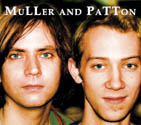 Muller and Patton Muller and PattonMuller and Patton (self-released) That would be Jaye Muller and Ben Patton, two guys who appear to be about 15 years old. They're not; at least, the music on this disc doesn't sound like the work of teenagers. It does sound like the work of folks who love late-60s pop music--Beatles, Beach Boys, etc. Lots of lush arrangements (layers of vocals as well as a fair amount of orchestration) and some really pretty songs. Do the songs really say something? Well...they're pop songs. They're not really intended to be particularly deep, so it can be a bit disconcerting when the occasional profundity pops out. Still, I think most folks can handle that. Yeah, that was sarcasm. And there's very little of that here. This is earnest, straightforward, well-built pop music. Very pretty. Very very pretty. Bright enough to bring the sun to an arctic winter's day. Contact:
������������������������������������� 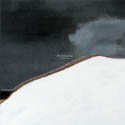 My Education
My EducationItalian (Thirty Ghosts) A more fully-orchestrated version of that haunting, high lonesome sound that I described in my review of the Esmerine above. My Education actually sounds a lot more like Dirty Three--the guitar and viola help. Of course, with six members this stuff really fills the sonic canvas at times. Like a midwestern spring day, these songs can go from full sun, to hail, to rain, to snow and then back to sun, all in the course of a few minutes. Some pretentious farts might even call that storytelling. Gosh, all this sarcasm just keeps rolling out. I don't know why. These songs are great. They have that rolling rhythm that, well, reminds me of the prairie. You look in any direction and you think you can see forever. I suppose the test with music like this isn't so much "Do the songs tell stories?," but rather "Are the stories compelling?" Yes, they are. Gorgeous, heartwrenching, compelling...you name it. A most impressive set of work.
Contact:
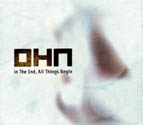 Ohn OhnIn the End, All Things Begin (self-released) Some might call this acid jazz, but I think what we have here is a fine representation of electronic funk. Mellow funk, to be sure. I know, a lot of folks would call mellow funk "happy jazz," but I don't. There is a difference. And it lies in the way these songs come together. I can't be sure, but I think the band recorded its tracks, and then they were somewhat reassembled in the studio. And when I say band, I mean a full workup, complete with DJ and horns. Ohn uses its horns more as jazz ornamentation than actual funk drivers, but I think that's just a nice way of moving the flavor. Then there are songs like "Bubblegum," which bring out both the funk and the acid jazz. I suppose I could go mad trying to shoehorn these folks into a box, but that's a dumb idea. Ohn is Ohn, and that's enough. Nice little jams for your next party or intimate get-together. A word of warning: There are ideas on this disc. It's not quite mindless. I think that's a good thing, myself, but it might lend itself to some issues, depending on your agenda when you're playing the disc. Just thought you'd like to know.
Contact:
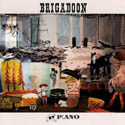 P:ano P:anoBrigadoon (Mint) More Canadian pop goofiness from the fine folks at Mint. P:ano isn't, in fact, riffing through the songs of the musical "Brigadoon." Yes, that would be a hoot, but this is so much dorkier. And let's not kid ourselves: Folks who like their pop music this involved are, indeed, dorks. I've been a dork for as long as I can remember. And if that means I get to enjoy music like this, I can live that. P:ano tends to build its songs around rhythm elements--whether that is piano or drums or whatever. The melodies are often convoluted and a bit forced. I find that endearing, for some reason. It's probably the breathless nature of the songs. Even though the sound is generally understated and somewhat "acoustic" in feel (if you know what I mean), the songs simply keep moving along. No dirges. Nothing like that. Hell, any album that references both Half Japanese and New Order has to be kinda interesting, right? Well, this one is pretty durned intriguing. Weird, idiosyncratic...that and more. Exciting as hell? Oh yeah, that too. Sometimes it's very good to be a dork
Contact:
 Alina
Simone Alina
SimonePrettier in the Dark EP (Fractured Discs) It is something of a cliche to take a woman's raw voice and leave it out front, accompanying it with the barest of essentials--or at the very least, leaving the music well down in the mix. Think Edith Frost or Shannon Wright or PJ Harvey (at times) or plenty others. This technique does raise the emotional quotient, but it can come off as a cheap studio trick if the song doesn't actually have the necessary punch. Not here. Simone's open, direct voice is perfectly suited for this treatment. And while the music on this EP does take a back seat, there's plenty of interesting stuff in there as well. Sometimes cliches are true. Simone's talent is very real, and this six-song set proves it. A harrowing ride direct to the soul. Hang on at your own risk.
Contact:
���������������������������������� 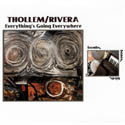 Thollem/Rivera Thollem/RiveraEverything's Going Everywhere (Edgetone) I reviewed an earlier album by the duo of Thollem McDonas and Rick Rivera a couple months back, and this new effort is even more impressive. McDonas's piano playing is bright and expressive, and Rivera's drumming holds these songs together with tight rhythms and an almost virtuosic repertoire of sounds. And, yes, this is almost entirely drums and piano. That's a pretty good thing, in my book, as the piano (played properly) is an orchestra unto itself. McDonas and Rivera riff off each other, trading licks and adding layer after layer to these pieces. But don't get the idea that these are improvisations. They're well-crafted. The sound is very sterile--jazz studio, essentially. After all, this is--at its heart--a jazz record. That it appeals to so many folks on the outside is just a plus. Lots of fun, which is sometimes hard to say with so many notes flying by. These guys know how to make exciting music, no matter what you want to call it.
Contact:
�������������������������������������  Variable Unit
Variable UnitMayhemystics Outbeaks (Wide Hive) The latest from Variable Unit, a new disc and not remixes of Mayhem Mystics--just so you're not confused. This Bay-Area hip-hop/jazz collective knows how to craft some truly inspirational jams. Some smooth and some rough, but all decidedly incendiary. If it seems like I'm not writing a whole lot about this, you're right. Variable Unit is best experienced on its own merits. I could write reams, but it would all boil down to the fact that VU is something unique in the hip-hop world: a set of experienced pros who have the singular mission of making important music and important rhymes. Yeah, the lyrics are great, but the music behind them is even more impressive. Play it again. And again. And so on.
Contact:
Come together: Compilations, etc.
Various Artists Dear Johnny... A Tribute to CASH (Hairball 8)
Various Artists This Is Indie Rock, Volume Two (Deep Elm)
Various Artists Voices in the Wilderness: Dissenting Soundscapes and
Songs of G.W.'s America (Pax Recordings)
Also recommended: Anaphylaxis Noise for Lovers
(Parasomnic)
Arms of Kismet Cutting Room Rug (Wampus Multimedia)
The Che Guevara Memorial Marching (and Stationary) Accordion Band The
Che Guevara Memorial Marching (and Stationary) Accordion Band (Public
Eyesore)
Coltrane Motion No Well OK Maybe Just a Little EP
(Datawaslost)
Matt Davignon Bwoo (Edgetone)
Girlyman Little Star (Daemon)
Gliss Halfway Gone EP (Mountain Lo-Fi)
The Gun Shys The Gun Shys (Aeronaut/Intravenous)
The Fareed Haque Group Cosmic Hug (Magnatude)
Eric Kolo Sketches EP (self-released)
The Mad Maggies Crazed and Enthused (self-released)
More Dogs Never Let Them Catch You Crying EP (Monitor)
No Wait Wait No Wait Wait (Chairkickers' Union Music)
The Old Haunts Fallow Field (Kill Rock Stars)
Pacific Ocean Fire Pacific Ocean Fire (Smokeylung)
Roué Upward Heroic Motive (Exit Stencil)
Velcro Mary Gold Trim on Fresh Fruit EP (self-released) ������������������������������������� | |
return to A&A home page